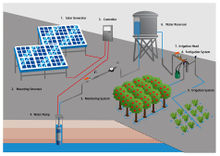Knowledge fuels change - Support energypedia!
For over 10 years, energypedia has been connecting energy experts around the world — helping them share knowledge, learn from each other, and accelerate the global energy transition.
Today, we ask for your support to keep this platform free and accessible to all.
Even a small contribution makes a big difference! If just 10–20% of our 60,000+ monthly visitors donated the equivalent of a cup of coffee — €5 — Energypedia would be fully funded for a whole year.
Is the knowledge you’ve gained through Energypedia this year worth €5 or more?
Your donation keeps the platform running, helps us create new knowledge products, and contributes directly to achieving SDG 7.
Thank you for your support, your donation, big or small, truly matters!
SPIS Toolbox - Solar - powered Irrigation Systems

| ►Back to the Start Page | ►Back to the Module Page | ►Go to the Next Chapter |
1.4 Solar Powered Irrigation Systems
Using solar energy for irrigation makes a lot of sense. First, irrigation is often implemented in rural areas with poor access to reliable electricity or fossil fuel supplies. Second, solar radiation is an abundant resource, especially in regions where rain water scarcity makes irrigation essential to food security and international trade. Finally, Solar Powered Irrigation Systems (SPIS) passively self-regulate because the volume of water pumped increases on clear hot days when plants need more water, and vice versa. It is important to note that a SPIS is more than just a solar pump used for irrigation. Panels, pumps and irrigation systems are designed on the basis of water availability and local crop water requirements. SPIS is a system where the different components, from pump to plant, are integrated and harmonized.
Operating Principle
The operating principle of an SPIS is simple. A solar generator provides electricity for an electric motor pump, which delivers water either directly into an irrigation system or to an elevated reservoir. Fundamental design criteria for SPIS include minimum maintenance, maximum reliability as well as resource efficiency. A specific characteristic of SPIS is the fact that generally a battery back-up is not required. This is an advantage since batteries are maintenance-intensive, costly and require regular replacement.
SPIS components
The individual components of a SPIS are introduced in the following sections. The table below shows that, depending on site-specific conditions and capacities of the farmer, different technology options are available. The components and alternative technologies can be combined with each other in a wide range of ways, but some configurations are better depending on the situation in the field.
Major alternative technologies for the most important components of an SPIS
| Component | Alternative technologies |
Dependent on: | |
| Solarsystem |
fixed |
tracking | costs and maintenance intensity |
| Pump |
surface |
submersible | costs and (geo-)hydrology |
| Reservoir |
reservoir |
no reservoir | costs and irrigation system |
| Irrigation system |
surface |
drip or sprinkler | costs and pumping system |
SPIS configurations
The most common SPIS configuration is when a solar generator on a fixed mounting structure provides electricity for a submersible pump installed in a borehole. The water is then pumped to a reservoir elevated a few meters above the field where it is stored at a constant pressure. When released, it flows into a low pressure drip irrigation system where the water is filtered and mixed with fertilizer before reaching the plants. This configuration is shown in the figure below.
However, the installation of the water filter on the exit/output side of the tank can be critical/problematic, as the pressure losses in the filter can easily reach/be several meters, and then, at low tank heights, there is no water flowing any longer. Therefore it is recommendable to install the filter on the input side, to keep the water clean in the tank.
This configuration would also be possible with a tracking system, but would require higher investment and more maintenance than a fixed mounting of the solar panels. The reservoir provides stable pressure and water supplies to the drip irrigation system in order to make water distribution as uniform as possible. The performance of drip irrigation decreases when the drippers get clogged by small particles in the water. Filters prevent this, but only when properly designed for the particular water quality and irrigation system, and only when regularly cleaned. Therefore, it is strongly recommended to use drip irrigation only in combination with groundwater as groundwater is generally cleaner than water from rivers or open reservoirs. Furthermore, it is recommended to have a monitoring system installed between the pump and the reservoir to measure the water flow and pressure.
The simplest SPIS configuration is when a solar generator on a fixed mounting structure provides electricity for a surface pump installed at a reservoir or river. The water is then pumped directly to a surface irrigation system, e.g. through a network of open canals. In this configuration the pumped water does not pass through an elevated reservoir. The pressure and pump flow to the irrigation system corresponds to the actual solar irradiance, which varies over the course of the day, especially with a fixed mounted solar generator. The main advantage of this configuration is the simple installation and relatively low costs. However, main drawback is that the producer has little control on the distribution of water in the field over the day as there is no reservoir that regulates flow and pressure. The producer will have to use volumetric valves (see IRRIGATION HEAD) or divide his field into manageable sub-sections to control the watering of the crops as best as possible.
Another configuration to be found in the field is a hybrid solution, where a solar-powered pump and a diesel pump are both used for irrigation.
| ►Back to the Start Page | ►Back to the Module Page | ►Go to the Next Chapter |





















